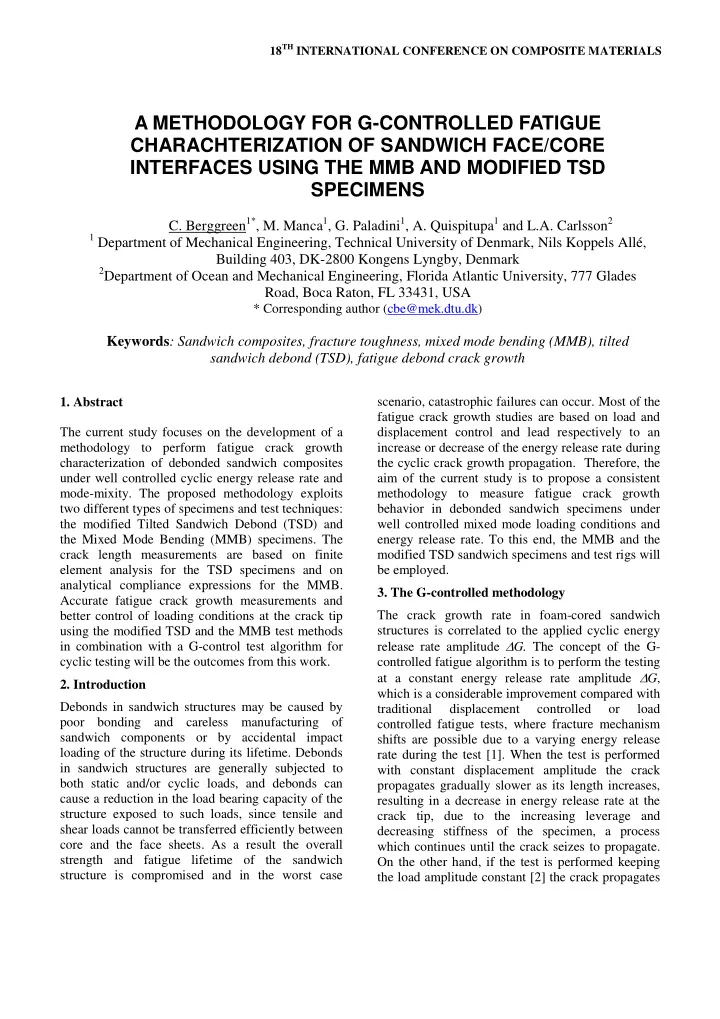

18 TH INTERNATIONAL CONFERENCE ON COMPOSITE MATERIALS A METHODOLOGY FOR G-CONTROLLED FATIGUE CHARACHTERIZATION OF SANDWICH FACE/CORE INTERFACES USING THE MMB AND MODIFIED TSD SPECIMENS C. Berggreen 1* , M. Manca 1 , G. Paladini 1 , A. Quispitupa 1 and L.A. Carlsson 2 1 Department of Mechanical Engineering, Technical University of Denmark, Nils Koppels Allé, Building 403, DK-2800 Kongens Lyngby, Denmark 2 Department of Ocean and Mechanical Engineering, Florida Atlantic University, 777 Glades Road, Boca Raton, FL 33431, USA * Corresponding author (cbe@mek.dtu.dk) Keywords : Sandwich composites, fracture toughness, mixed mode bending (MMB), tilted sandwich debond (TSD), fatigue debond crack growth scenario, catastrophic failures can occur. Most of the 1. Abstract fatigue crack growth studies are based on load and The current study focuses on the development of a displacement control and lead respectively to an methodology to perform fatigue crack growth increase or decrease of the energy release rate during characterization of debonded sandwich composites the cyclic crack growth propagation. Therefore, the under well controlled cyclic energy release rate and aim of the current study is to propose a consistent mode-mixity. The proposed methodology exploits methodology to measure fatigue crack growth two different types of specimens and test techniques: behavior in debonded sandwich specimens under the modified Tilted Sandwich Debond (TSD) and well controlled mixed mode loading conditions and the Mixed Mode Bending (MMB) specimens. The energy release rate. To this end, the MMB and the crack length measurements are based on finite modified TSD sandwich specimens and test rigs will element analysis for the TSD specimens and on be employed. analytical compliance expressions for the MMB. 3. The G-controlled methodology Accurate fatigue crack growth measurements and better control of loading conditions at the crack tip The crack growth rate in foam-cored sandwich structures is correlated to the applied cyclic energy using the modified TSD and the MMB test methods release rate amplitude G. The concept of the G- in combination with a G-control test algorithm for cyclic testing will be the outcomes from this work. controlled fatigue algorithm is to perform the testing at a constant energy release rate amplitude G , 2. Introduction which is a considerable improvement compared with Debonds in sandwich structures may be caused by traditional displacement controlled or load poor bonding and careless manufacturing of controlled fatigue tests, where fracture mechanism sandwich components or by accidental impact shifts are possible due to a varying energy release loading of the structure during its lifetime. Debonds rate during the test [1]. When the test is performed in sandwich structures are generally subjected to with constant displacement amplitude the crack both static and/or cyclic loads, and debonds can propagates gradually slower as its length increases, cause a reduction in the load bearing capacity of the resulting in a decrease in energy release rate at the structure exposed to such loads, since tensile and crack tip, due to the increasing leverage and shear loads cannot be transferred efficiently between decreasing stiffness of the specimen, a process core and the face sheets. As a result the overall which continues until the crack seizes to propagate. strength and fatigue lifetime of the sandwich On the other hand, if the test is performed keeping structure is compromised and in the worst case the load amplitude constant [2] the crack propagates
gradually faster because of the increasing energy release rate at the crack tip until the crack reaches the specimen edge (Fig.1). In both cases the energy release rate varies extensively during the test, and crack kinking into different face/core interface crack paths is possible, resulting in non-consistent crack growth rate measurements. Fig.2. MMB test rig and specimen In order to perform fatigue testing at constant energy release rate, the static face/core interface fracture toughness was initially determined at various mixed mode loadings. Sinusoidal fatigue loading with R=0.2 and 2 Hz testing frequency were employed for the study of cyclic crack growth. The fatigue debond length a was monitored and measured visually and also calculated using the compliance (eq.1) and the energy release rate (eq.2) expressions combined with the actual load and displacement data Fig.1. Testing modes for fatigue crack growth from fatigue tests [5]. evaluation. Load ( P ), displacement ( D ) and energy release rate ( G ) control modes 2 c c L c c L c L C C C C MMB DCB _ upper DCB _ lower CSB L 2 L L 2 L L In order to perform fatigue testing at constant energy (1) release rate, two different sandwich test configurations are used. c c c L 12 2 1 / 4 1 / 2 a 2 a L L 2 L 3 E h 4. The sandwich MMB configuration f f 2 P G MMB 2 2 The sandwich G-controlled test method is based on 2 b 2 2 c L c c L 1 a c L a 1 1 2 L L 2 L h G 2 L 8 D D B the conventional mixed mode bending test method c xz debonded intact D A [3] where the specimen is subjected to a combination of mode I and mode II (Fig.2). (2) However, modifications to the kinematic condition have been developed in order to accommodate The crack length was used to determine the instantly sandwich specimens with non-negligible shear applied energy release rate G , using an advanced deformations [4-5]. The sandwich MMB test has control algorithm programmed into the servo- earlier been applied for both fracture toughness hydraulic controller software. In this control characterization [6] as well as conventional load and algorithm, the instant value of G applied to the displacement controlled cyclic fatigue sandwich specimen is compared to the initial energy characterization [7-8]. release rate, G 0 , and if the condition G=G 0 is not fulfilled the displacement amplitude applied to the specimen is adjusted instantaneously through the servo-hydraulic control loop.
Recommend
More recommend